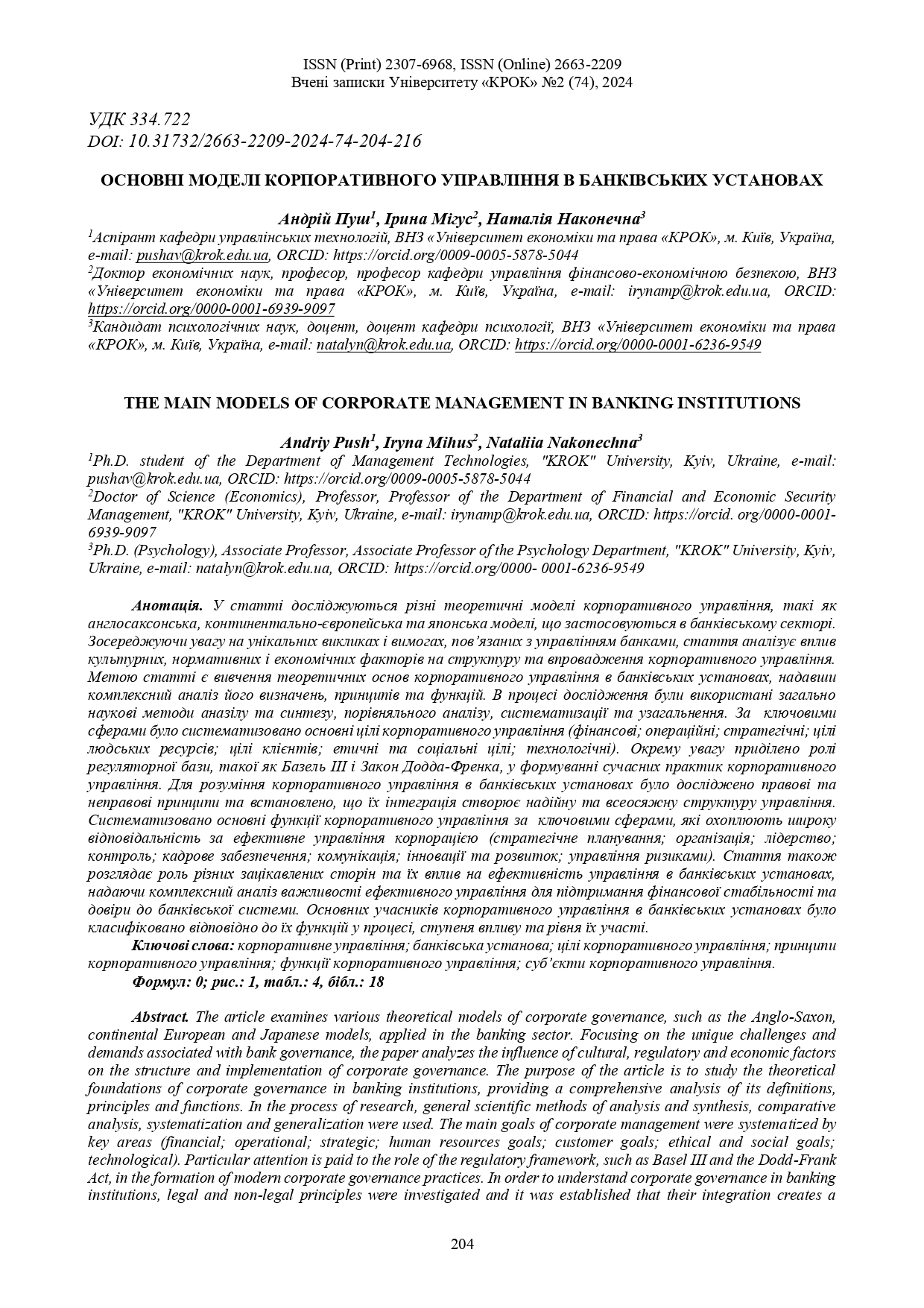THE MAIN MODELS OF CORPORATE MANAGEMENT IN BANKING INSTITUTIONS
DOI:
https://doi.org/10.31732/2663-2209-2024-74-204-216Keywords:
corporate management, banking institution, goals of corporate governance, principles of corporate governance, functions of corporate management, subjects of corporate governanceAbstract
The article examines various theoretical models of corporate governance, such as the Anglo-Saxon, continental European and Japanese models, applied in the banking sector. Focusing on the unique challenges and demands associated with bank governance, the paper analyzes the influence of cultural, regulatory and economic factors on the structure and implementation of corporate governance. The purpose of the article is to study the theoretical foundations of corporate governance in banking institutions, providing a comprehensive analysis of its definitions, principles and functions. In the process of research, general scientific methods of analysis and synthesis, comparative analysis, systematization and generalization were used. The main goals of corporate management were systematized by key areas (financial; operational; strategic; human resources goals; customer goals; ethical and social goals; technological). Particular attention is paid to the role of the regulatory framework, such as Basel III and the Dodd-Frank Act, in the formation of modern corporate governance practices. In order to understand corporate governance in banking institutions, legal and non-legal principles were investigated and it was established that their integration creates a reliable and comprehensive management structure. The main functions of corporate management are systematized by key areas that cover broad responsibility for effective management of the corporation (strategic planning; organization; leadership; control; human resources; communication; innovation and development; risk management). The article also examines the role of various stakeholders and their impact on the effectiveness of governance in banking institutions, providing a comprehensive analysis of the importance of effective governance in maintaining financial stability and confidence in the banking system. The main participants of corporate governance in banking institutions were classified according to their functions in the process, degree of influence and level of their participation.Downloads
References
Alatassi, B., & Letza, S. (2018). Best practice in bank corporate governance: The case of Islamic Banks. Economics and Business Review, 4(4), 115–133. https://doi.org/10.18559/ebr.2018.4.7
Aoki, M. (2001). Toward a Comparative Institutional Analysis. MIT Press.
Basel Committee on Banking Supervision. (2011). Basel III: A global regulatory framework for more resilient banks and banking systems. Bank for International Settlements.
Butzbach, O., Rotondo, G. & Desiato, T. (2020). Can banks be owned?. Accounting, Economics, and Law: A Convivium, 10(1), 20170004. https://doi.org/10.1515/ael-2017-0004
Clarke, T. (2007). International corporate governance: A comparative approach. Routledge.
Davis, J. H., Schoorman, F. D., & Donaldson, L. (1997). Toward a stewardship theory of management. Academy of Management Review, 22(1), 20-47.
Freeman, R. E. (1984). Strategic Management: A Stakeholder Approach. Pitman.
Huang, R. (2019). Digital finance and changes in corporate governance in banking. Finance & Development, 56(4), 46-49.
Jassaud, N. (2014). Reforming the corporate governance of Italian banks. International Monetary Fund. DOI: https://doi.org/10.5089/9781484387511.001
Jensen, M. C., & Meckling, W. H. (1976). Theory of the firm: Managerial behavior, agency costs and ownership structure. Journal of Financial Economics, 3(4), 305-360.
Kohlbacher, Thomas and Groeneveld, Hans, Risk-taking, information production and the competitive advantage of cooperative banking groups: new theoretical considerations (August 28, 2023). Available at SSRN: https://ssrn.com/abstract=4554039 or http://dx.doi.org/10.2139/ssrn.4554039
La Porta, R., Lopez-de-Silanes, F., Shleifer, A., & Vishny, R. W. (2002). Investor protection and corporate governance. Journal of Financial Economics, 58(1-2), 3-27.
Levine, R. (2004). The corporate governance of banks: A concise discussion of concepts and evidence. World Bank Policy Research Working Paper, No. 3404.
Maysyaroh, S. ., Rusydiana, A. S. ., & Febriani, D. . (2024). Zillennial Perceptions of Sharia Governance Implementation and Its Implications on the Reputation, Trust, and Loyalty of Islamic Banks. Jurnal Ekonomi Syariah Teori Dan Terapan, 11(1), 105–120. https://doi.org/10.20473/vol11iss20241pp105-120
Rissy, Y.Y.W. The stakeholder model: its relevance, concept, and application in the Indonesian banking sector. J Bank Regul 22, 219–231 (2021). https://doi.org/10.1057/s41261-020-00140-2
Shleifer, A., & Vishny, R. W. (1997). A survey of corporate governance. Journal of Finance, 52(2), 737-783.
Sullivan, R. (2020). ESG factors in banking: From risk to opportunity. Journal of Sustainable Finance & Investment, 10(2), 205-222.
Корпоративне управління в системі економічної безпеки акціонерних товариств України [І.П. Мігус, Л. М. Худолій, М.П.Денисенко, С.П. Міхно] - Черкаси: ТОВ «Маклаут» – 2012. - 274 с.

Downloads
Published
How to Cite
Issue
Section
License

This work is licensed under a Creative Commons Attribution-NonCommercial 4.0 International License.

